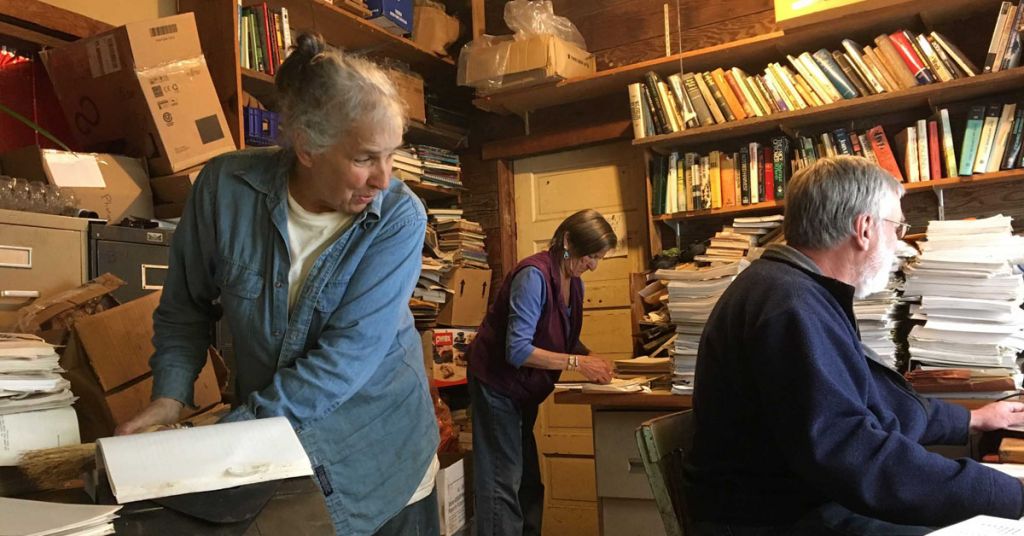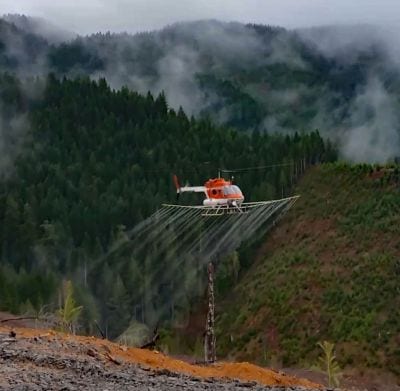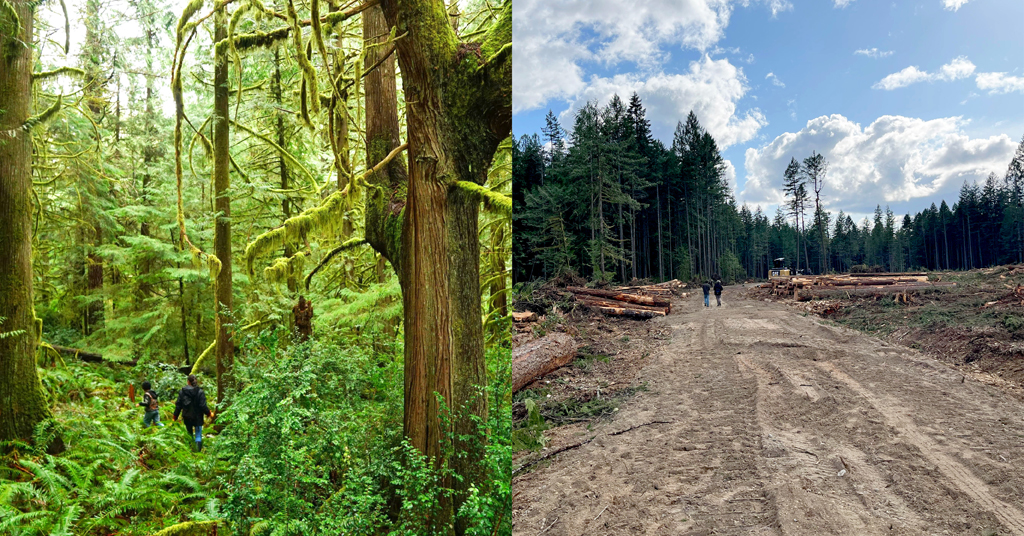The People vs. Agent Orange tracks ongoing activism against the aerial spraying of mutagenic herbicides over Oregon forests

In a new documentary, Dr. James Clary acknowledges in the first and only filmed interview he’s ever given that as a USAF officer and scientist in Vietnam “we knew” Agent Orange was toxic to humans. Film still by Dyanna Taylor
By Chuck Thompson. June 21, 2021. The toxic herbicide known as Agent Orange is most notoriously associated with the Vietnam War. Between 1962 and 1971, as part of Operation Ranch Hand, the U.S. Air Force sprayed as much as 20 million gallons over Vietnam and neighboring countries in an effort at mass deforestation and enemy food denial.
But the deadly, mutagenic poison “dioxin,” central to Agent Orange’s gruesome effectiveness, is still in wide use today, most indiscriminately by logging concerns as part of weed-killing herbicides sprayed over forests in Oregon, Washington and Idaho.
Meanwhile, chemical manufacturers such as Dow and Monsanto continue to evade criminal liability for the disease, birth defects and deaths their products spread.
This is the grim message of a powerful new documentary, The People vs. Agent Orange, which premiers June 28 (Monday) as part of PBS’ Independent Lens series.
“It’s a myth that the Agent Orange catastrophe is history,” say filmmakers Alan Adelson and Kate Tevarna. “Toxic herbicides are a pressing human health, environmental and civic challenge facing our society today.”
The film received the Organization of American Historians 2021 Erik Barnouw Award for outstanding programming.
Goliath still winning
The 90-minute documentary interweaves the story of two women central to citizen-led legal fights against chemical manufacturers of herbicides.
As a young woman during the Vietnam War, Tran To Nga was doused with Agent Orange; she’s suffered multiple horrific effects, including cancer and children with birth defects.

Oregon resident Carol Van Strum (left) and team scan thousands of chemical company documents collected over decades. They’re available on The Poison Papers and Toxic Docs websites. Photo by Risa F. Scott
Since the forests around her home in Lincoln County, Oregon, were continually sprayed with versions of the deadly toxin in the 1970s, Carol Van Strum has devoted her life to stopping the use of more than 750 herbicides the film says continue to spread the deadly legacy of Agent Orange around the Pacific Northwest and world.
Those who’ve been around Oregon long enough may be familiar with Van Strum’s story. She gained prominence in the 1970s and ‘80s as a founder of Citizens Against Toxic Spraying (C.A.T.S.), becoming the face of a legal battle that resulted in a dramatic but ultimately insufficient court victory over the U.S. government in a David and Goliath war Goliath continues to dominate.
“We have the right to protect all of our communities from being poisoned,” says Van Strum in a blunt summation of her work.
Both women have suffered unspeakable personal tragedies as a result of exposure to herbicides known as 2,4,5-T and 2,4-D, which when mixed form Agent Orange, so named for orange-colored markings on the barrels originally shipped to U.S. troops in Vietnam. The documentary lays out their stories in heartbreaking and sometimes graphic detail.
Yes, they’re still spraying
The People vs. Agent Orange is haunting. It’s impossible not to flinch from footage of severely deformed children in hospital wards.

This clandestine footage shot by a helicopter technician documents herbicide spraying on a rainy day in Oregon. The rain washes chemicals into nearby streams and a reservoir. Film still by Darryl Ivy
Undercover video of workers in 2015 spraying Oregon forests and watersheds with toxic herbicides is upsetting in a different way.
Timber companies employ helicopter pilots to spray herbicides on plantation forests to kill weeds, shrubs and other plants that compete with Douglas fir and other trees harvested by the industry.
At least according to court renderings, it’s been difficult for victims of herbicide spraying to establish a causal link between their maladies and the chemicals to which they were exposed against their will.
MORE: A believable solution to climate change? This film may have it
Chemical makers have steadfastly denied culpability.
More maddening to litigants, institutions including the U.S. Environmental Protection Agency, U.S. Forest Service, Bureau of Land Management and even Oregon Sate University professors have consistently lined up with the corporations to testify that Agent Orange and its chemical spawn are “about as toxic as aspirin,” as one chemical industry flack smirkingly contends in the film.
It’d be nice to call The People vs. Agent Orange compelling history.
It’s partly that.
But as the opening scene of a group of contemporary picnickers at Douglas County, Oregon’s Swiftwater Park shows, the tragedy it documents is of a public that continues to be unwitting bystanders in a campaign of mass destruction that’s never actually ended.
The People vs. Agent Orange, June 28, PBS, Independent Lens
Chuck Thompson is editor of Columbia Insight.











The EPA banned dioxin in 1985. It is not sprayed on this country’s forests. Stop lying. Oh, and there’s no need to secretly follow a helicopter, ya drama queens. LOL
This is a sadly incorrect and inflammatory article. Dioxin is a very toxic chemical. However, it was a contaminant in the production of 2,4,5-T by Dow chemical, and does not have herbicidal properties. This contamination was due to scaled up production for a military contract with Dow. Yes, it is nasty stuff, but was banned as mentioned in this article. 2,4,5-T has also been a long banned herbicide because, if manufactured incorrectly, can lead to dioxin contamination in the final product. This article sadly reiterates false and misleading information that has long been ranted by anti-pesticide radicals. The herbicide products used today in forestry have low mammalian toxicity, so pose a negligible risk to people. Herbicide drift on the other hand can be an issue if you happen to be an off-target plant.
Yes you need to watch the show – you do not have all the information –
Then why is the US cleaning up the biggest clean up site in Vietnam at Bien Hoa? My husband was declared 100 % disabled by the VA due to agent orange. We also worked in these forests in Idaho before 1985 and I know!!!! I am positive my miscarriages were caused by exposure to these chemicals. Unless you have worked and have these diseases you will never know. You, Mr. Ball, sound like you are trying to give false information. Are you a researcher>?
The Health and Medicine Division (formally known as the Institute of Medicine) of the National Academy of Sciences, Engineering, and Medicine concluded in its 1994 report “Veterans and Agent Orange: Health Effects of Herbicides Used in Vietnam” and other updates that there is evidence of a positive association between exposure to herbicides used in Vietnam and soft tissue sarcomas. The government knows!!!
Why not watch the documentary tonight on PBS and then make up your mind?
Good comment. Thanks
The documentary is fascinating, and watchable online.
Good article, great documentary, necessary knowledge – Thank you
Christina W.Yours was a good comment, why didn’t you tell us where and when to see it ? Lump
My husband and I both worked in those forests before 1985. He was also exposed to this chemical in Vietnam 67-68. He died i 2020 and was 100% military disabled due to this Chemical. It is no wonder we had those miscarriages.
I just finished reading,” Damnation Spring” by Ash Davidson about the logging and spraying the Pacific Northwest. The book has made me curious to investigate this subject. I highly recommend you read the novel to get a personal perspective on the subject. I am just beginning to learn all I can so I can’t offer any insight but the practice is very troubling. Stanford Lucille Packard Hospital in my community sees many birth defects from the central valley of California, areas where crops are routinely sprayed. Friends who teach in the area have been trying to get the companies to stop spraying within one mile of the elementary schools. On spraying days the children are coughing, sneezing and complain of headaches and fatigue. This subject is not history but a continuing struggle.
i was exposed at NATO 23 Germany, i have had chloracne and the cysts. One son, down syndrome one 13 days old who is dead. 3 girls with learning disabilities. this was at a Nuclear sight in Germany. this was 1982-83 stationed their 45 days.
A great documentary (available through Amazon Prime)– though heartbreaking, I was left with tremendous gratitude for Carol and Tran To Nga.
2,4-D in lawn applications have seriously impacted my own health and I continue to be horrified at how little personal choice I (and all of us) have to avoid toxic pesticides in our environment. There is a global movement with volunteers in every part of the world working for the elimination of toxic, synthetic pesticides. Great resources can be found through Pesticide Action Network, Beyond Pesticides, and many other organizations
Anyone can google search Dioxin, agent Orange used in the US, agent Orange test sites in the US, etc., what you or anyone will find is alarming. Just like the “forever chemical” that has contaminated hundreds of military bases and has been found in drinking water on and off base. When Agent Orange was allegedly banned, how many pallets of 55 gallon drums were all over every base in the US as well as around the world? It is noted that all of the pallets of agent Orange were gathered and shipped to bikini atoll in the Marshall Islands and sealed under a concrete dome. I served for 32 years and have personally witnessed 55 gallon drums of whatever concentrated substance sit and rot away with the contents leaking out and killing everything around it. Take a look at the studies with Camp Lejuene and the contaminated water, guess what! Dioxin was found. Look at Marine Corps Air Station at El Toro, it is worse than Camp Lejuene but covered up as quickly as it can be as the Air Station is PRIME real estate. How many barrels have been buried on every military base, work wide, over many decades. Made a Air Force base found 88, 55 gallon drums of concentrated agent Orange buried beneath a school the US built. When a substance was discovered oozing up from the ground, testing was conducted immediately…..guess what, digging up the ground to discover exactly what the substance was, 88, 55 gallon drums, clearly marked with an orange colored paint around the center of the barrel, identifying it was agent Orange. Yet, the records do not show agent Orange being used at Kadena. Hello. How many re rods are incomplete, have been destroyed, etc.
Anyone can google search Dioxin, agent Orange used in the US, agent Orange test sites in the US, etc., what you or anyone will find is alarming. Just like the “forever chemical” that has contaminated hundreds of military bases and has been found in drinking water on and off base. When Agent Orange was allegedly banned, how many pallets of 55 gallon drums were all over every base in the US as well as around the world? It is noted that all of the pallets of agent Orange were gathered and shipped to bikini atoll in the Marshall Islands and sealed under a concrete dome. Guess what – a liner was never used when it was decided that all the radiated waste from hydrogen bomb testing in bikini atoll would be sealed beneath the concrete dome along with the thousands of pallets with 55 gallon drums of agent Orange would also be disposed under the dome. What happens to steel drums after decades? They rot, rust, leak whatever contents was within the 55 gallon drums, etc. the liquids are now leaching beneath the dome! I served for 32 years, was stationed around the Globe and have personally witnessed 55 gallon drums of whatever concentrated substance sit and rot away with the contents leaking out and killing everything around it. Take a look at the studies with Camp Lejuene and the contaminated water, guess what! Dioxin was found. Look at Marine Corps Air Station at El Toro, it is worse than Camp Lejuene but covered up as quickly as it can be as the Air Station is PRIME real estate. How many barrels have been buried on every military base, world wide, over many decades. Kadena Air Force base found 88, 55 gallon drums of concentrated agent Orange buried beneath a school that the US built. When a substance was discovered oozing up from the ground, testing was conducted immediately…..guess what, digging up the ground to discover exactly what the substance was, 88, 55 gallon drums, clearly marked with an orange colored paint around the center of the barrel, identifying the barrels as agent Orange. Yet, the records do not show agent Orange being used at Kadena. Hello. How many records are incomplete, have been destroyed, etc. Guam is more polluted with Dioxin/agent Orange than Vietnam. Guam was the staging area loading up the planes with the agent Orange.
My father-in-law died from multiple cancers directly linked to agent orange based on multiple oncologists opinions and his wife had it officially acknowledged by the US military and received survivor benefits after a long struggle to get it recognized. Poison. If anyone is still spraying it they are committing murder. Plain and simple.